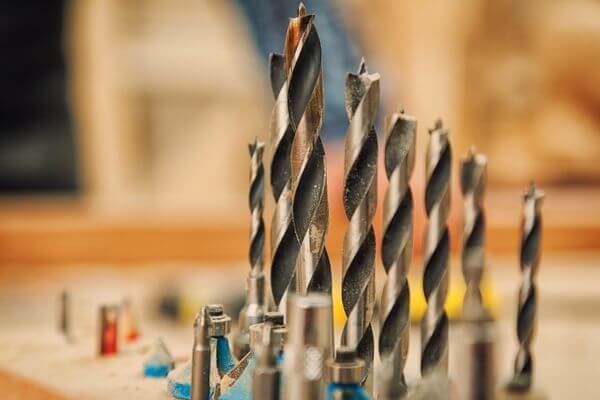Most industrial and DIY projects require drilling, and choosing the right drill bit is critical to achieving the best results. Drill bits with split points have become increasingly popular in recent years. Split point drill bits were first invented in the 1960s. Originally used to bore into multiple materials, they have evolved over time. What is a split point drill bit, its design and advantages, applications, how to choose the right one, and maintenance tips will be discussed in this article.

What is a Split Point Drill Bit?
Split point drill bits have a pointed tip divided into two oppositely angled sections. As a result, the drill bit cuts through materials more quickly and precisely than a conventional drill bit. The two angled sections create a force that helps to break up the material as the drill bit is inserted. This force helps to push the material away from the bit and reduces the friction and heat generated from the cutting process, resulting in a smoother, more precise cut.

Design of Split Point Drill Bits
If you look at the tip of a drill bit under a magnifying glass, you can see the split point design. A small angle, typically around 135 degrees, separates the two flutes at the very tip of the drill bit. A good angle ensures that chips are extracted from the hole while preventing the drill bit from walking or wandering while drilling.
Advantages of Split Point Design
Split point drill bits are self-centered, so they cut through material more efficiently and with greater precision due to their self-centering capabilities. Additionally, the drill bit is less likely to wander or “walk” during drilling, so the hole is drilled at the desired angle and location. Precision is critical when drilling through hard or dense materials.
Furthermore, the split point design reduces burrs and rough edges left after drilling, which is vital in metalworking and woodworking applications that require a clean hole.
Materials used for Split Point Drill Bits
- High-Speed Steel (HSS) – is a common material used for split point drill bits due to its high strength, durability, and heat resistance.
- Cobalt Steel – a type of HSS with higher cobalt content, provides excellent wear resistance and toughness.
- Carbide – a rigid and brittle material that is highly resistant to wear and abrasion. Carbide drill bits are commonly used for drilling hard materials.
- Titanium Nitride (TiN) Coating – a thin coating applied to drill bits to increase their hardness, lubricity, and resistance to wear and heat.
- Black Oxide Coating – a coating applied to drill bits to increase their resistance to wear and corrosion.
- Polycrystalline Diamond (PCD) is a synthetic diamond material used for drilling rigid materials.
- Tungsten Carbide – a hard and durable material used to drill hard materials such as metal, masonry, and tiles.
- High-Speed Steel with Cobalt (HSS-Co) – a type of HSS with added cobalt for increased strength, durability, and heat resistance.
Applications of Split Point Drill Bits

- Metal Working: Split point drill bits are widely used in metalworking applications, such as drilling holes in aluminum, steel, brass, and other metals. They are perfect for creating clean, precise holes in metalwork because they are self-centering and have reduced burrs.
- Woodworking: Split point drill bits are popular in woodworking applications such as drilling hardwoods, softwoods, and plywood. They are ideal for drilling pilot holes for screws and other fasteners because of their sharp pointed tip and self-centering capabilities.
- Plastic Drilling: Drilling through plastics such as PVC, acrylics, and polycarbonates is possible using split point drill bits. Plastic is less likely to be damaged by reduced burrs and self-centering capabilities.
- Concrete and Masonry Drilling: Split point carbide drill bits are used for drilling through concrete and masonry. It is possible to drill clean, precise holes in these tough materials thanks to the carbide material and design.
- Automotive: Split point drill bits are commonly used to drill through engine blocks, transmission casings, and other metal components. Auto components benefit from the self-centering capability and reduced burrs of these drills.
- Home renovations, furniture assembly, and general repairs are common DIY projects that utilize split point drill bits. They are ideal for DIY enthusiasts because they are self-centering and require less force to start drilling.
How to Choose the Right Split Point Drill Bit
- Material to be drilled: Take into account the type of material that will be drilled. Materials and coatings for drill bits must be different for different materials. It is ideal for drilling through aluminum with HSS while drilling through masonry with carbide is more appropriate.
- It is also essential to consider the diameter of the hole when choosing a drill bit. The larger the hole’s diameter, the larger the drill bit required. Also, smaller drill bits are more likely to break, so it’s crucial to select a drill bit that is appropriate for the task.
- Drill bit length: The length of the drill bit required depends on the depth of the hole. Shorter drill bits are better suited for shallow holes, while longer drill bits are better for deep holes.
- You should also consider the type of shank of the drill bit. If you want to use a drill press, you should use a straight shank, while when you want to use a cordless drill, you should use a hex shank. It is also possible to purchase drill bits with quick-change shanks, making it easier to change bits.
- Consider the drill bit’s coating. Drilling through soft materials is best done with a titanium coating, while drilling through more challenging materials is best done with a black oxide coating. For high-speed drilling, a cobalt coating provides additional heat resistance.
- A drill bit’s point angle also affects its performance. When it comes to softer materials, a smaller angle is better, and when it comes to tougher materials, a larger angle is better.
- A high-quality drill bit and a reputable brand are essential to achieving the best results. A low-quality drill bit may last less or perform as well as a higher-quality one.
Split point drill bit vs. Standard Drill bit – Comparison Table
| Feature | Split Point Drill Bit | Standard Drill Bit |
| Point Angle | 135 degrees | 118 degrees |
| Starting | Self-centering | Requires pilot hole |
| Cutting | Reduced walking and skipping | More prone to walking and skipping |
| Chip removal | More efficient and less clogging | More prone to clogging |
| Materials | Suitable for hard and soft materials | Primarily suited for soft materials |
| Precision | More accurate and precise | Less precise and accurate |
| Speed and Efficiency | Faster and more efficient | Slower and less efficient |
| Durability | Less prone to breakage | More prone to breakage |
| Cost | More expensive | Less expensive |
Maintenance and care of Split Point drill bits
- Remove any debris or dirt from the drill bit after use.
- During drilling, lubricate the drill bit periodically to prevent overheating.
- Keep the drill bit dry, clean, and organized.
- Maintain the drill bit’s sharpness and accuracy by sharpening it with a sharpening stone or file.
- While drilling, use the correct speed and lubrication to avoid overheating the drill bit.
- To avoid poor results or potential danger, replace damaged or worn-out drill bits immediately.
- Select the correct drill bit for the job to avoid damaging the drill bit or the material.
- Replace the drill bit if it shows signs of wear and tear.
- Protect the drill bit when not in use by using a protective case or sleeve.
- Follow the drill bit manufacturer’s instructions for proper care and maintenance.
What is a Split Point Drill Bit – FAQs
1. What are the advantages of using a split point drill bit?
The split point drill bit is more accurate and efficient, has better chip removal, and is less likely to walk or skip than standard drill bits. In addition to drilling hard materials, they are also suitable for drilling soft materials.
2. Can split point drill bits be used for drilling soft materials?
Yes, split point drill bits can be used to drill soft materials, but they are best used to drill hard materials. For drilling soft materials, standard drill bits are better suited.
3. How do I sharpen a split point drill bit?
You can use a sharpening stone or file to sharpen a split point drill bit. Maintaining the original point angle of 135 degrees and sharpening both sides of the drill bit equally is essential.
In Conclusion
The split point drill bit has a self-centering design and a point angle of 135 degrees, reducing walking and increasing precision when drilling. Compared to standard drill bits, split point drill bits are more accurate and efficient, have better chip removal, and are less likely to walk or skip. You can achieve accurate and efficient drilling results by using the right split point drill bit and maintaining it properly.
More Resources:
5 Best Drill Bit for Drilling Out Locks
